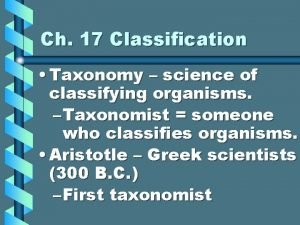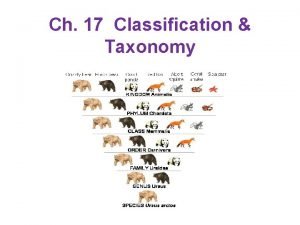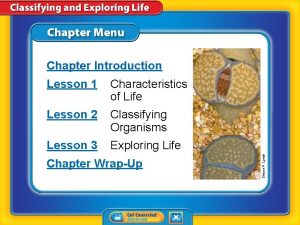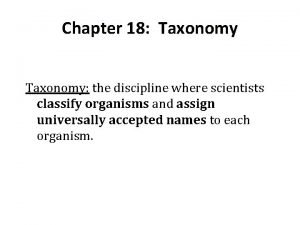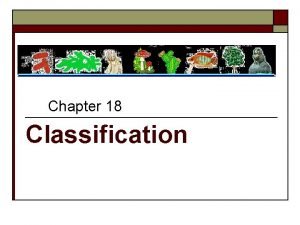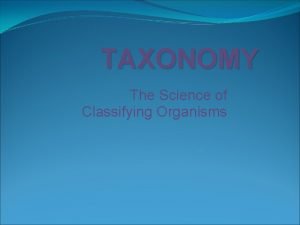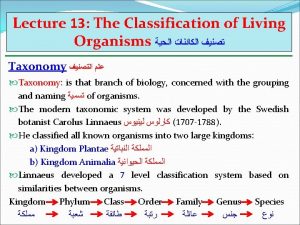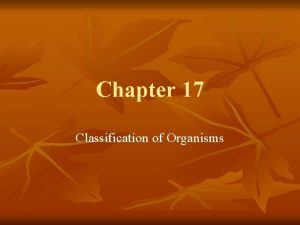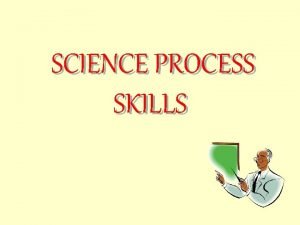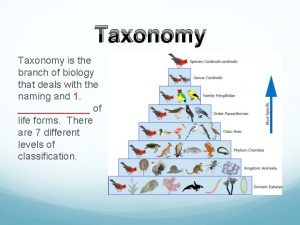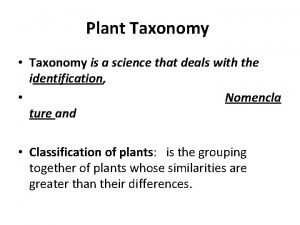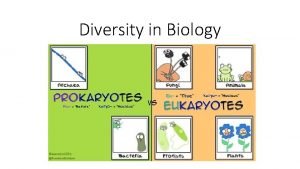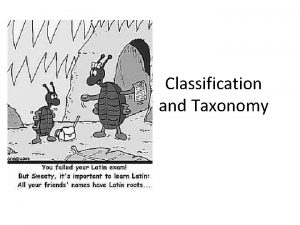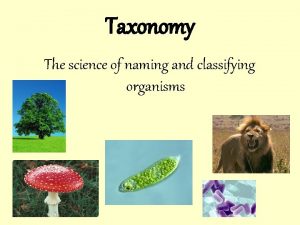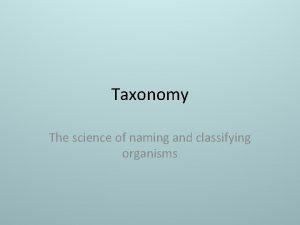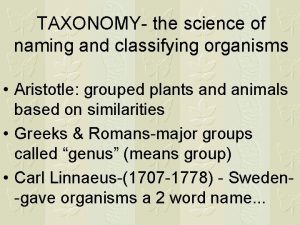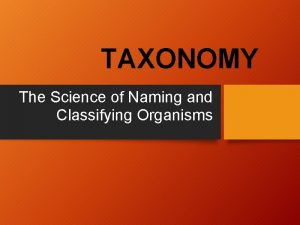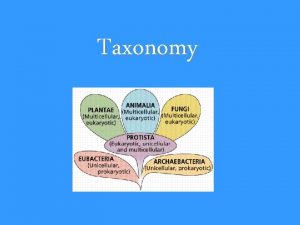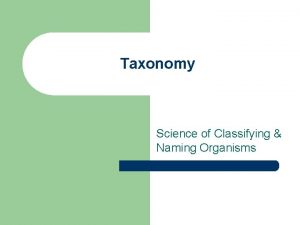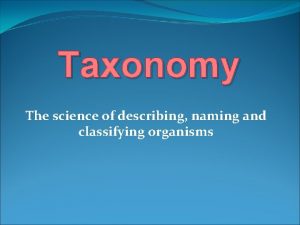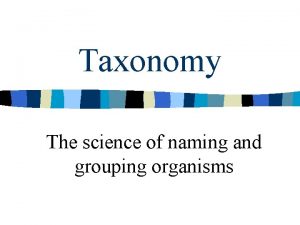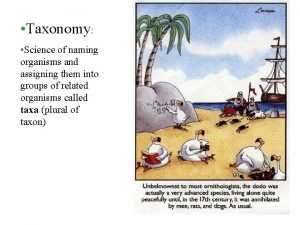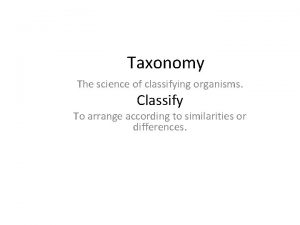Taxonomy The science of naming and classifying organisms
































- Slides: 32

Taxonomy The science of naming and classifying organisms

Linnaeus developed the scientific naming system still used today • Binomial nomenclature is a two-part scientific naming system. • uses Latin words • scientific names always written in italics or underlined • two parts are the genus name and species descriptor

White oak: Quercus alba Barn owl: Tyto alba

• A genus includes one or more physically similar species. – Species in the same genus are thought to be closely related. – Genus name is always capitalized. • A species descriptor is the second part of a scientific name. – always lowercase – always follows genus name; never written alone

• Ursus maritimus Ursus arctos horribilis (horribilis is the subspecies)


Scientific names help scientists to communicate. • Some species have very similar common names. • Some species have many common names.

Linnaeus’ classification system has seven levels.

How can you remember these levels? • • Kingdom Phylum Class Order Family Genus Species __________ __________

Cladistics is classification based on common ancestry. • Phylogeny is the evolutionary history for a group of species. – evidence from living species, fossil record, and molecular data – shown with branching tree diagrams

-derived traits are shown with numbers 1 -4 - organisms are shown with letters A-D

Cladogram

1) Which traits do the Sinornis and Velociraptor share? 2) Which animal has the most traits? 3) Does the Allosaurus have down feathers?

Make a cladogram for quarter, dime, nickel, penny

• Cladistics is a common method to make evolutionary trees – classification based on common ancestry – species placed in order that they descended from common ancestor

Molecular clocks use mutations to estimate evolutionary time. • Mutations add up at a constant rate in related species. – As more time passes, there will be more mutations. Mutations add up at a fairly constant rate in the DNA of species that evolved from a common ancestor. DNA sequence from a hypothetical ancestor Ten million years later— one mutation in each lineage Another ten million years later— one more mutation in each lineage The DNA sequences from two descendant species show mutations that have accumulated (black). The mutation rate of this sequence equals one mutation per ten million years.

• Mitochondrial DNA is used to study closely related species. – mutation rate ten times faster than nuclear DNA – passed down unshuffled from mother to offspring grandparents mitochondrial DNA nuclear DNA parents Mitochondrial DNA is passed down only from the mother of each generation, so it is not subject to recombination. child Nuclear DNA is inherited from both parents, making it more difficult to trace back through generations.

The current tree of life has three domains.

Classification is always a work in progress. • The tree of life shows our most current understanding. • New discoveries can lead to changes in classification. – Until 1866: only two kingdoms, Animalia and Plantae Animalia

– Until 1866: only two kingdoms, Animalia and Plantae – 1866: all single-celled organisms moved to kingdom Protista Animalia Protista

– Until 1866: only two kingdoms, Animalia and Plantae – 1866: all single-celled organisms moved to kingdom Protista Animalia Protista – 1938: prokaryotes moved to kingdom Monera

– Until 1866: only two kingdoms, Animalia and Plantae – 1866: all single-celled organisms moved to kingdom Protista Animalia Protista – 1938: prokaryotes moved to kingdom Monera – 1959: fungi moved to own kingdom Monera Fungi

– Until 1866: only two kingdoms, Animalia and Plantae – 1866: all single-celled organisms moved to kingdom Protista Animalia Protista – 1938: prokaryotes moved to kingdom Monera – 1959: fungi moved to own kingdom Archea Fungi Bacteria – 1977: kingdom Monera split into kingdoms Bacteria and Archaea

The three domains in the tree of life are Bacteria, Archaea, and Eukarya. • Domains are above the kingdom level. – proposed by Carl Woese based on r. RNA studies of prokaryotes – domain model more clearly shows prokaryotic diversity

• Domain Bacteria includes prokaryotes in the kingdom Bacteria. – one of largest groups on Earth – classified by shape, need for oxygen, and diseases caused

• Domain Archaea includes prokaryotes in the kingdom Archaea. – cell walls chemically different from bacteria – differences discovered by studying RNA – known for living in extreme environments

• Domain Eukarya includes all eukaryotes. – kingdom Protista

• Domain Eukarya includes all eukaryotes. – kingdom Protista – kingdom Plantae

• Domain Eukarya includes all eukaryotes. – kingdom Protista – kingdom Plantae – kingdom Fungi

• Domain Eukarya includes all eukaryotes. – kingdom Protista – kingdom Plantae – kingdom Fungi – kingdom Animalia

• Bacteria and archaea can be difficult to classify. – transfer genes among themselves outside of reproduction bridge to transfer DNA – blurs the line between “species” – more research needed to understand prokaryotes

• http: //www. peabody. yale. edu/exhibits/tree oflife/films. html
 Do you italicize scientific names
Do you italicize scientific names The science of naming and classifying organisms
The science of naming and classifying organisms Homo taxonomy
Homo taxonomy The scientific discipline of classifying organisms
The scientific discipline of classifying organisms Discipline of classifying and naming organisms
Discipline of classifying and naming organisms Discipline of classifying and naming organisms
Discipline of classifying and naming organisms What is the hierarchical system used to classify organisms?
What is the hierarchical system used to classify organisms? This is the study of grouping and naming organisms
This is the study of grouping and naming organisms Domain kingdom phylum class
Domain kingdom phylum class Marzano's taxonomy
Marzano's taxonomy Organism
Organism Lesson 2 classifying organisms answer key
Lesson 2 classifying organisms answer key Classifying organisms worksheet
Classifying organisms worksheet Lesson outline classifying organisms
Lesson outline classifying organisms Lesson 2 classifying organisms answer key
Lesson 2 classifying organisms answer key The scientific discipline of classifying organisms
The scientific discipline of classifying organisms Finding order in diversity
Finding order in diversity Organisms taxonomy
Organisms taxonomy Organisms taxonomy
Organisms taxonomy Organisms taxonomy
Organisms taxonomy Taxonomy in biology
Taxonomy in biology Member of the same species
Member of the same species My favourite subject maths for class 4
My favourite subject maths for class 4 Manipulative science process skills
Manipulative science process skills Science process skills definition
Science process skills definition Taxonomy is the branch of science that deals with –
Taxonomy is the branch of science that deals with – Study of plants
Study of plants King philip coughed on fred and he got sick
King philip coughed on fred and he got sick Loculicidal capsule fruit
Loculicidal capsule fruit Taxonomy is the science that deals with
Taxonomy is the science that deals with Naming and writing formulas for acids and bases
Naming and writing formulas for acids and bases Introducing and naming new products and brand extensions
Introducing and naming new products and brand extensions Introducing and naming new products and brand extensions
Introducing and naming new products and brand extensions





